button Alfa Romeo Giulietta 2013 Owner handbook (in English)
[x] Cancel search | Manufacturer: ALFA ROMEO, Model Year: 2013, Model line: Giulietta, Model: Alfa Romeo Giulietta 2013Pages: 292, PDF Size: 13.06 MB
Page 107 of 292
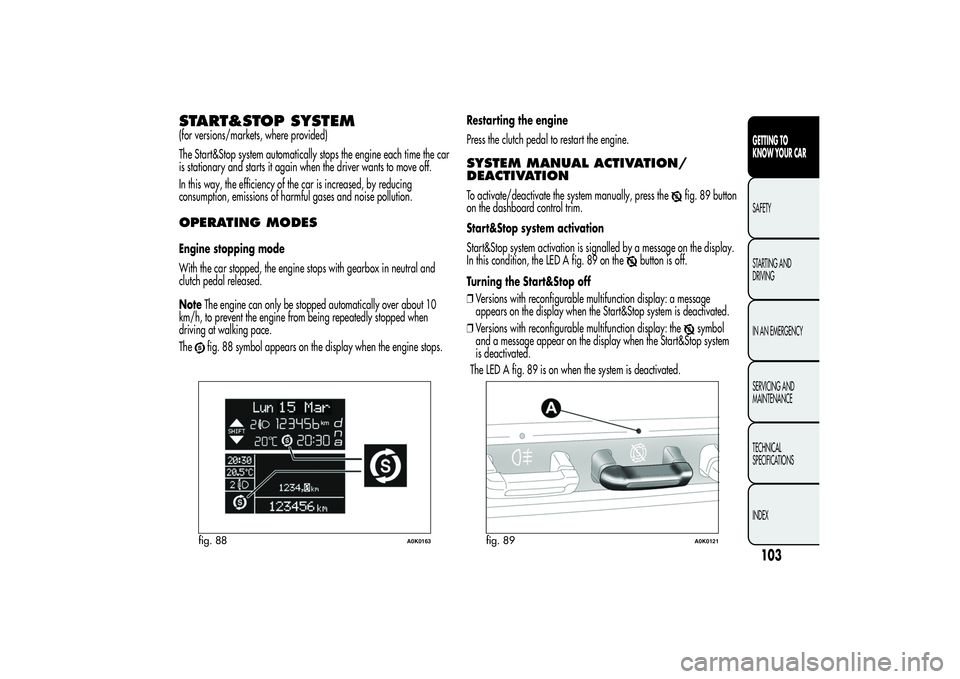
START&STOP SYSTEM(for versions/markets, where provided)
The Start&Stop system automatically stops the engine each time the car
is stationary and starts it again when the driver wants to move off.
In this way, the efficiency of the car is increased, by reducing
consumption, emissions of harmful gases and noise pollution.OPERATING MODESEngine stopping mode
With the car stopped, the engine stops with gearbox in neutral and
clutch pedal released.
NoteThe engine can only be stopped automatically over about 10
km/h, to prevent the engine from being repeatedly stopped when
driving at walking pace.
The
fig. 88 symbol appears on the display when the engine stops.Restarting the engine
Press the clutch pedal to restart the engine.
SYSTEM MANUAL ACTIVATION/
DEACTIVATIONTo activate/deactivate the system manually, press the
fig. 89 button
on the dashboard control trim.
Start&Stop system activation
Start&Stop system activation is signalled by a message on the display.
In this condition, the LED A fig. 89 on the
button is off.
Turning the Start&Stop off
❒Versions with reconfigurable multifunction display: a message
appears on the display when the Start&Stop system is deactivated.
❒Versions with reconfigurable multifunction display: the
symbol
and a message appear on the display when the Start&Stop system
is deactivated.
fig. 88
A0K0163
fig. 89
A0K0121
103GETTING TO
KNOW YOUR CARSAFETY
STARTING AND
DRIVING
IN AN EMERGENCY
SERVICING AND
MAINTENANCE
TECHNICAL
SPECIFICATIONS
INDEX
The LED A fig. 89 is on when the system is deactivated.
Page 109 of 292

SAFETY FUNCTIONSWhen the engine is stopped by the Start&Stop system, if the driver
releases his/her seat belt and opens the driver's or passenger's door,
the engine can be restarted only using the ignition key.
The driver is informed by a buzzer and by the flashing of the symbol
on the display; on some versions, a message is displayed as well.
"ENERGY SAVING" FUNCTION(for versions/markets, where provided)
If, following automatic engine restarting, the driver does not carry out
any action on the car for over 3 minutes, the Start&Stop system stops
the engine once and for all, to prevent fuel consumption. In these
cases, the engine can be restarted only using the ignition key.
NOTE In any case, it is possible to keep the engine running by
deactivating the Start&Stop system.IRREGULAR OPERATIONIn the event of malfunction, the Start&Stop system is deactivated.
The driver is informed of the fault by the flashing
symbol (versions
with multifunction display) or
symbol (versions with reconfigurable
multifunction display). For versions/markets where provided, a
message is also displayed.
In this case, contact Alfa Romeo Authorized Services.
CAR INACTIVITYIn the event of car inactivity (or if the battery is replaced), special
attention must be paid to the disconnection of the battery power
supply.
Proceed as follows: detach the connector A fig. 90 (by pressing button
B) from sensor C for monitoring the status of the battery installed on
the negative battery pole D. This sensor should never be disconnected
from the pole except if the battery is replaced.
In case of battery replacement, always contact Alfa
Romeo Authorized Services. Replace the battery with
one of the same type (HEAVY DUTY) and with the same
specifications.
IMPORTANT After turning the ignition key to STOP, wait at least 1
minute before disconnecting the electrical supply to the battery.
fig. 90
A0K0179
105GETTING TO
KNOW YOUR CARSAFETY
STARTING AND
DRIVING
IN AN EMERGENCY
SERVICING AND
MAINTENANCE
TECHNICAL
SPECIFICATIONS
INDEX
Page 119 of 292
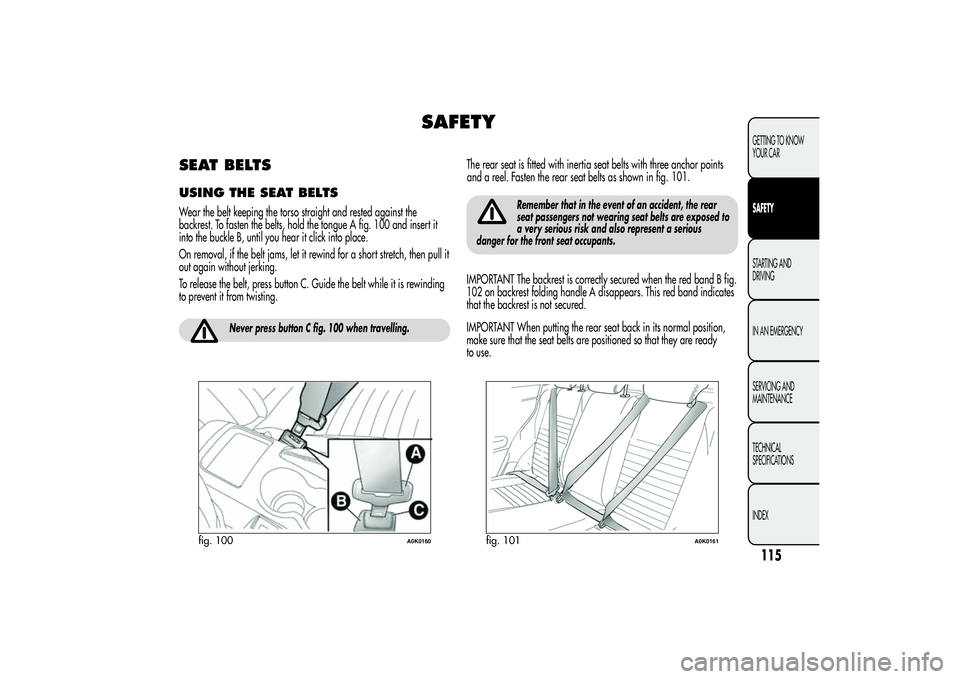
SAFETY
SEAT BELTSUSING THE SEAT BELTSWear the belt keeping the torso straight and rested against the
backrest. To fasten the belts, hold the tongue A fig. 100 and insert it
into the buckle B, until you hear it click into place.
On removal, if the belt jams, let it rewind for a short stretch, then pull it
out again without jerking.
To release the belt, press button C. Guide the belt while it is rewinding
to prevent it from twisting.
Never press button C fig. 100 when travelling.
The rear seat is fitted with inertia seat belts with three anchor points
and a reel. Fasten the rear seat belts as shown in fig.101.
Remember that in the event of an accident, the rear
seat passengers not wearing seat belts are exposed to
a very serious risk and also represent a serious
danger for the front seat occupants.
IMPORTANT The backrest is correctly secured when the red band B fig.
102 on backrest folding handle A disappears. This red band indicates
that the backrest is not secured.
IMPORTANT When putting the rear seat back in its normal position,
make sure that the seat belts are positioned so that they are ready
to use.
fig. 100
A0K0160
fig. 101
A0K0161
115GETTING TO KNOW
YOUR CARSAFETYSTARTING AND
DRIVING
IN AN EMERGENCY
SERVICING AND
MAINTENANCE
TECHNICAL
SPECIFICATIONS
INDEX
Page 139 of 292

Remember that the brake servo and electromechanical
power steering are not operational until the engine
has been started, therefore much more effort than
usual is required on the brake pedal and steering wheel.Never start the engine by pushing, towing or driving
downhill. These manoeuvres may damage the catalytic
converter.
WARMING UP THE ENGINE JUST
AFTER IT HAS STARTEDProceed as follows:
❒drive off slowly, letting the engine turn at medium revs and without
accelerating abruptly;
❒do not demand maximum performance for the first few kilometres. It
is advisable to wait until the engine coolant temperature indicator
starts moving.STOPPING THE ENGINETurn the ignition key to STOP while the engine is idling.
IMPORTANT After a demanding drive, before turning the engine off
you should allow it to idle to allow the temperature in the engine
compartment to decrease.
A quick burst on the accelerator before stopping the engine
serves absolutely no practical purpose. It wastes fuel and
is especially damaging to turbocharged engines.
PARKINGSwitch off the engine and pull up the handbrake. Engage a gear (1
stif
the car is facing uphill or reverse if it is facing downhill) and leave
the wheels steered to one side.
If the car is parked on a steep slope block the wheels with a wedge or
stone. Always remove the ignition key when leaving the car.
Never leave children unattended in the car. Always
remove the key from the ignition when leaving the car
and take it with you.
HANDBRAKETo engage the handbrake pull lever A fig. 118 upwards until the car is
secured. To release the handbrake, raise lever A slightly, hold down
button B and lower the lever.
fig. 118
A0K0073
135GETTING TO KNOW
YOUR CAR
SAFETYSTARTING AND
DRIVINGIN AN EMERGENCY
SERVICING AND
MAINTENANCE
TECHNICAL
SPECIFICATIONS
INDEX
Page 177 of 292
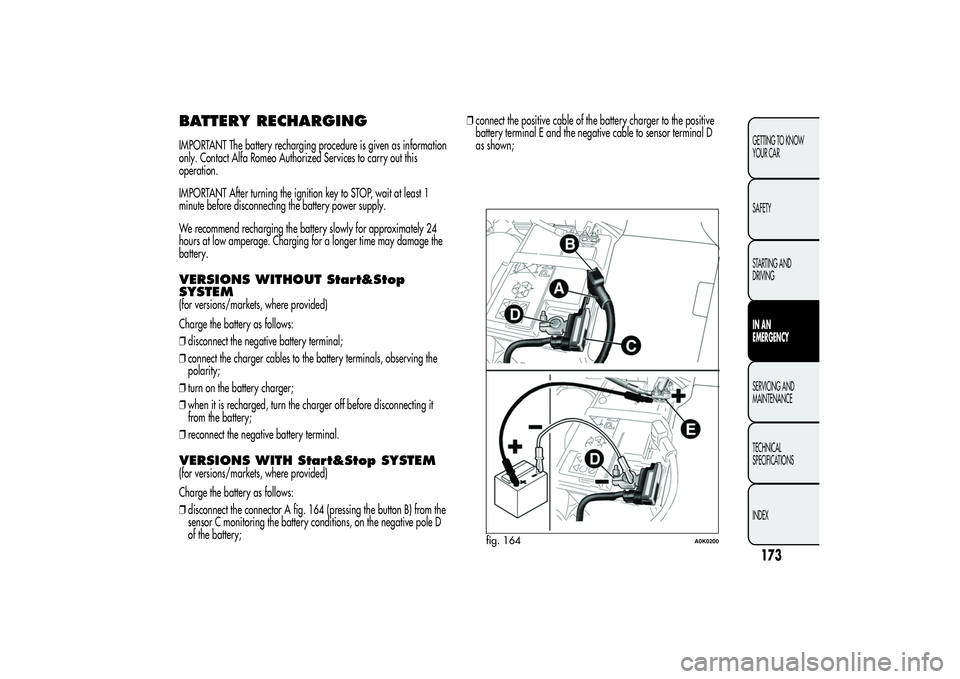
BATTERY RECHARGINGIMPORTANT The battery recharging procedure is given as information
only. Contact Alfa Romeo Authorized Services to carry out this
operation.
IMPORTANT After turning the ignition key to STOP, wait at least 1
minute before disconnecting the battery power supply.
We recommend recharging the battery slowly for approximately 24
hours at low amperage. Charging for a longer time may damage the
battery.VERSIONS WITHOUT Start&Stop
SYSTEM(for versions/markets, where provided)
Charge the battery as follows:
❒disconnect the negative battery terminal;
❒connect the charger cables to the battery terminals, observing the
polarity;
❒turn on the battery charger;
❒when it is recharged, turn the charger off before disconnecting it
from the battery;
❒reconnect the negative battery terminal.VERSIONS WITH Start&Stop SYSTEM(for versions/markets, where provided)
Charge the battery as follows:
❒disconnect the connector A fig. 164 (pressing the button B) from the
sensor C monitoring the battery conditions, on the negative pole D
of the battery;❒connect the positive cable of the battery charger to the positive
battery terminal E and the negative cable to sensor terminal D
as shown;
fig. 164
A0K0200
173GETTING TO KNOW
YOUR CAR
SAFETY
STARTING AND
DRIVINGIN AN
EMERGENCYSERVICING AND
MAINTENANCE
TECHNICAL
SPECIFICATIONS
INDEX
Page 237 of 292
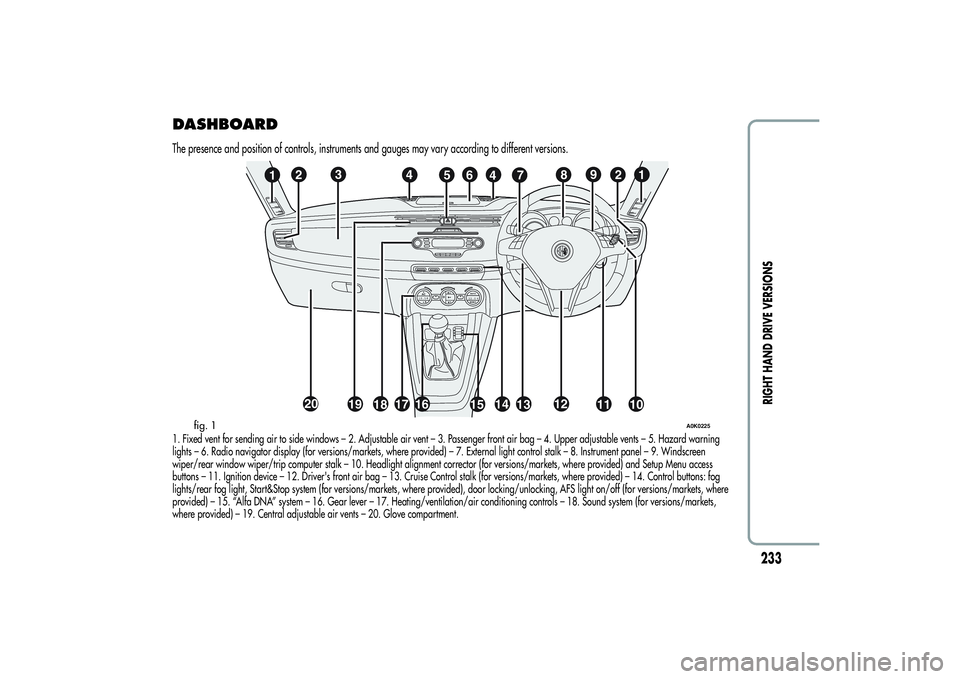
DASHBOARDThe presence and position of controls, instruments and gauges may vary according to different versions.1. Fixed vent for sending air to side windows – 2. Adjustable air vent – 3. Passenger front air bag – 4. Upper adjustable vents – 5. Hazard warning
lights – 6. Radio navigator display (for versions/markets, where provided) – 7. External light control stalk – 8. Instrument panel – 9. Windscreen
wiper/rear window wiper/trip computer stalk – 10. Headlight alignment corrector (for versions/markets, where provided) and Setup Menu access
buttons – 11. Ignition device – 12. Driver's front air bag – 13. Cruise Control stalk (for versions/markets, where provided) – 14. Control buttons: fog
lights/rear fog light, Start&Stop system (for versions/markets, where provided), door locking/unlocking, AFS light on/off (for versions/markets, where
provided) – 15. “Alfa DNA” system – 16. Gear lever – 17. Heating/ventilation/air conditioning controls – 18. Sound system (for versions/markets,
where provided) – 19. Central adjustable air vents – 20. Glove compartment.
19.5
22.0
cACA
AUTO
MONOC
123
4
56
4789
21
20
19
1817
16
1514
1312
1110
fig. 1
A0K0225
233
RIGHT HAND DRIVE VERSIONS
Page 243 of 292
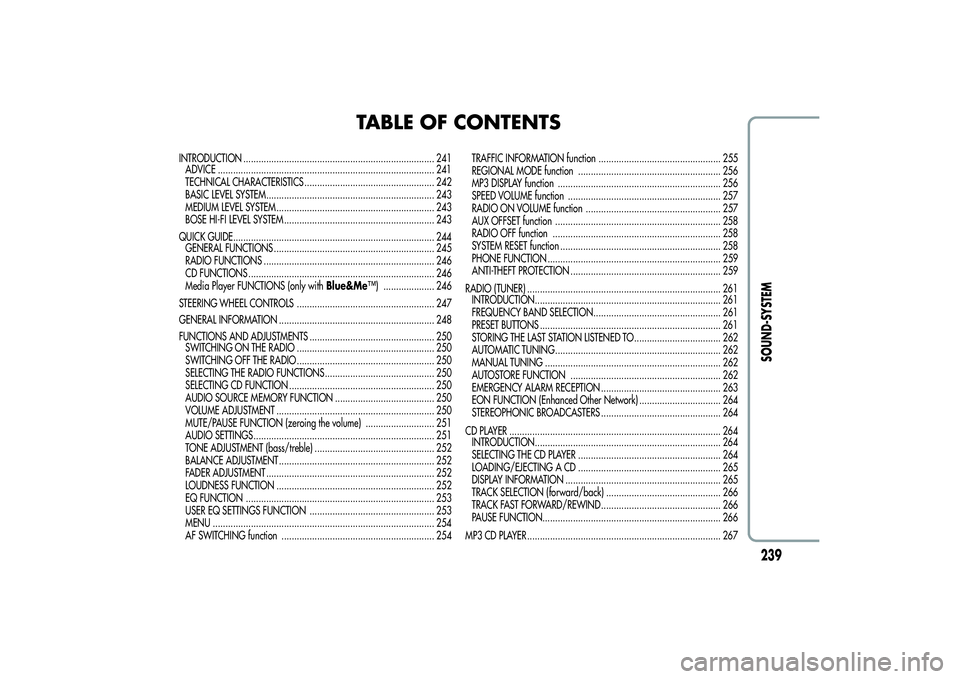
TABLE OF CONTENTS
INTRODUCTION ........................................................................... 241
ADVICE ..................................................................................... 241
TECHNICAL CHARACTERISTICS ................................................... 242
BASIC LEVEL SYSTEM.................................................................. 243
MEDIUM LEVEL SYSTEM .............................................................. 243
BOSE HI-FI LEVEL SYSTEM ........................................................... 243
QUICK GUIDE............................................................................... 244
GENERAL FUNCTIONS ............................................................... 245
RADIO FUNCTIONS ................................................................... 246
CD FUNCTIONS ......................................................................... 246
Media Player FUNCTIONS (only withBlue&Me™) .................... 246
STEERING WHEEL CONTROLS ...................................................... 247
GENERAL INFORMATION ............................................................. 248
FUNCTIONS AND ADJUSTMENTS ................................................. 250
SWITCHING ON THE RADIO ...................................................... 250
SWITCHING OFF THE RADIO ...................................................... 250
SELECTING THE RADIO FUNCTIONS ........................................... 250
SELECTING CD FUNCTION ......................................................... 250
AUDIO SOURCE MEMORY FUNCTION ....................................... 250
VOLUME ADJUSTMENT .............................................................. 250
MUTE/PAUSE FUNCTION (zeroing the volume) ........................... 251
AUDIO SETTINGS....................................................................... 251
TONE ADJUSTMENT (bass/treble) ............................................... 252
BALANCE ADJUSTMENT ............................................................. 252
FADER ADJUSTMENT .................................................................. 252
LOUDNESS FUNCTION .............................................................. 252
EQ FUNCTION .......................................................................... 253
USER EQ SETTINGS FUNCTION ................................................. 253
MENU ....................................................................................... 254
AF SWITCHING function ............................................................ 254TRAFFIC INFORMATION function ................................................ 255
REGIONAL MODE function ........................................................ 256
MP3 DISPLAY function ................................................................ 256
SPEED VOLUME function ............................................................ 257
RADIO ON VOLUME function ..................................................... 257
AUX OFFSET function ................................................................. 258
RADIO OFF function .................................................................. 258
SYSTEM RESET function ............................................................... 258
PHONE FUNCTION .................................................................... 259
ANTI-THEFT PROTECTION ........................................................... 259
RADIO (TUNER) ............................................................................ 261
INTRODUCTION......................................................................... 261
FREQUENCY BAND SELECTION.................................................. 261
PRESET BUTTONS ....................................................................... 261
STORING THE LAST STATION LISTENED TO.................................. 262
AUTOMATIC TUNING................................................................. 262
MANUAL TUNING ..................................................................... 262
AUTOSTORE FUNCTION ........................................................... 262
EMERGENCY ALARM RECEPTION ............................................... 263
EON FUNCTION (Enhanced Other Network) ................................ 264
STEREOPHONIC BROADCASTERS ............................................... 264
CD PLAYER ................................................................................... 264
INTRODUCTION......................................................................... 264
SELECTING THE CD PLAYER ........................................................ 264
LOADING/EJECTING A CD ........................................................ 265
DISPLAY INFORMATION ............................................................. 265
TRACK SELECTION (forward/back) ............................................. 266
TRACK FAST FORWARD/REWIND ............................................... 266
PAUSE FUNCTION...................................................................... 266
MP3 CD PLAYER ............................................................................ 267
239SOUND-SYSTEM
Page 249 of 292
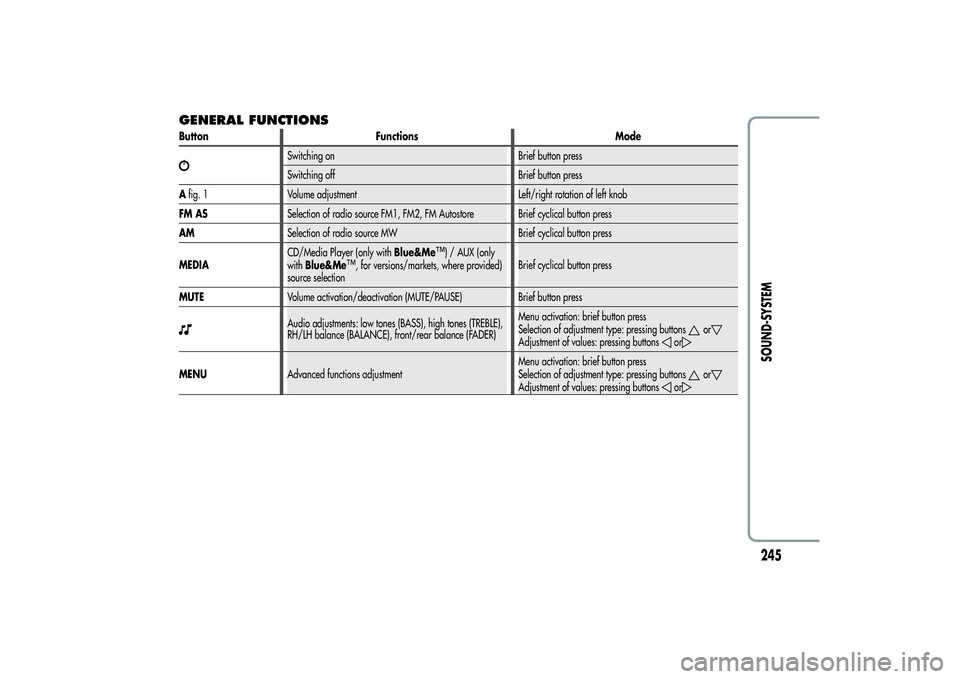
GENERAL FUNCTIONSButton Functions Mode
Switching on Brief button press
Switching off Brief button press
Afig. 1 Volume adjustment Left/right rotation of left knob
FM ASSelection of radio source FM1, FM2, FM Autostore Brief cyclical button press
AMSelection of radio source MW Brief cyclical button press
MEDIACD/Media Player (only withBlue&Me
™) / AUX (only
withBlue&Me
™, for versions/markets, where provided)
source selectionBrief cyclical button press
MUTEVolume activation/deactivation (MUTE/PAUSE) Brief button press
Audio adjustments: low tones (BASS), high tones (TREBLE),
RH/LH balance (BALANCE), front/rear balance (FADER)Menu activation: brief button press
Selection of adjustment type: pressing buttons
or
Adjustment of values: pressing buttons
or
MENUAdvanced functions adjustmentMenu activation: brief button press
Selection of adjustment type: pressing buttons
or
Adjustment of values: pressing buttons
or
245SOUND-SYSTEM
Page 250 of 292
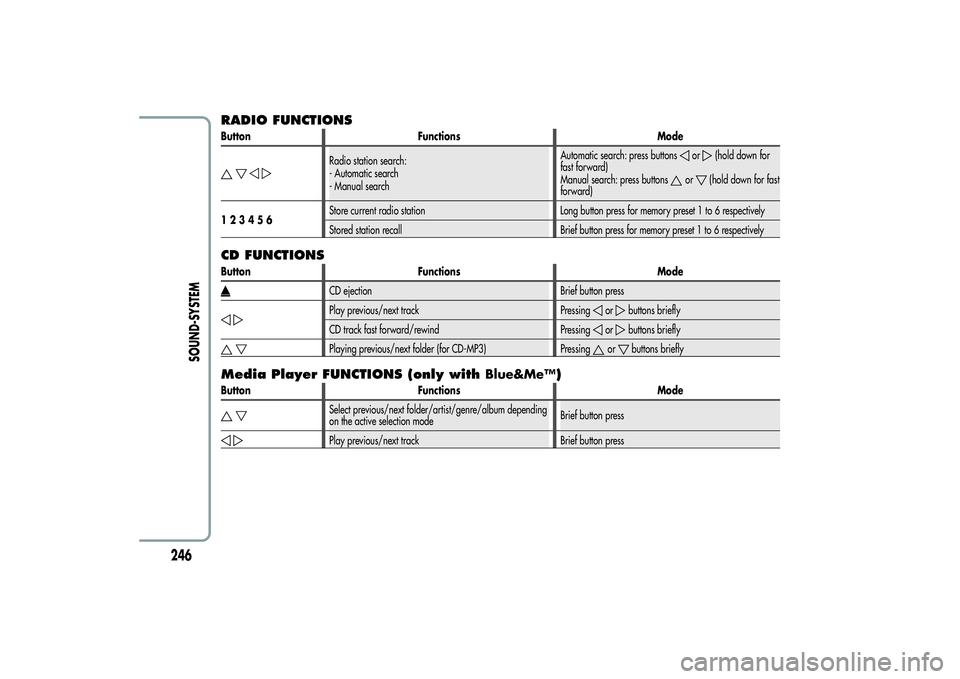
RADIO FUNCTIONSButton Functions Mode
Radio station search:
- Automatic search
- Manual searchAutomatic search: press buttons
or
(hold down for
fast forward)
Manual search: press buttons
or
(hold down for fast
forward)
123456Store current radio station Long button press for memory preset 1 to 6 respectively
Stored station recall Brief button press for memory preset 1 to 6 respectively
CD FUNCTIONSButton Functions Mode
CD ejection Brief button pressPlay previous/next track Pressing
or
buttons briefly
CD track fast forward/rewind Pressing
or
buttons briefly
Playing previous/next folder (for CD-MP3) Pressing
or
buttons briefly
Media Player FUNCTIONS (only withBlue&Me™)Button Functions Mode
Select previous/next folder/artist/genre/album depending
on the active selection modeBrief button pressPlay previous/next track Brief button press
246
SOUND-SYSTEM
Page 251 of 292

STEERING WHEEL CONTROLS(for versions/markets, where provided)Button Functions Mode
AudioMute on/off (Radio mode) or Pause function in MP3 or Media
Player mode (only withBlue&Me
™)Brief button press
+Volume increase Button press
–Volume decrease Button press
SRCSelection of Radio frequency range (FM1, FM2, FMT, FMA, MW)
and audio sources: Radio, MP3 or Media Player (only with
Blue&Me
™) /AUX (only withBlue&Me
™)
(for versions/markets, where provided)Button press
Radio: recall stored stations (from 1 to 6) CD/CD MP3: select next
trackButton pressRadio: recall stored stations (from 6 to 1) CD/CD MP3: select
previous trackButton press
NOTEStarting from the FM or AM source set on the radio (e.g. FM1 or MW1), if you cycle through the audio sources using the SRC
button among the steering wheel controls (stopping on a source other than radio) when the radio source is selected (FM or AM) using the
buttons on the radio panel, the radio always switches to the last radio source (FMA or MW2).
fig. 2
A0K0118
247SOUND-SYSTEM